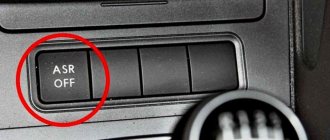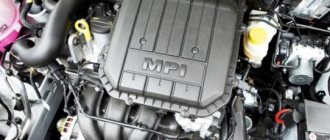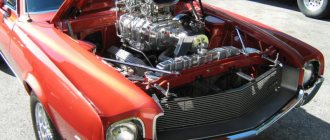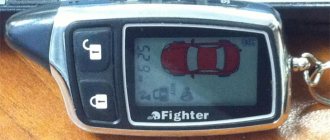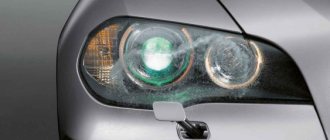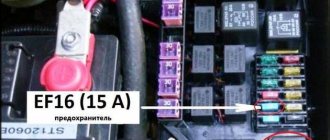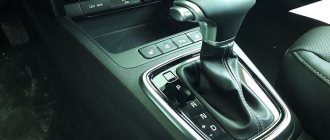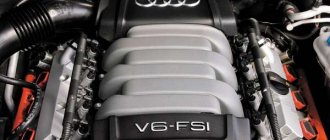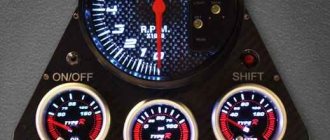In 1957, German engineers Felix Wankel and Walter Freude demonstrated the first working rotary engine. Just seven years later, its improved version took its place under the hood of the German sports car NSU-Spider - the first production car with such an engine. Many automobile companies, Citroen and General Motors, bought the new product. Even VAZ produced cars with Wankel engines in small batches for many years. But the only company that decided on large-scale production of rotary engines and did not abandon them for a long time, despite any crises, was Mazda. Its first model with a rotary engine, the Cosmo Sports (110S), appeared back in 1967.
rotor2
The remaining working cavities work the same way. And since there are three cavities, then in one revolution of the rotor there are as many as three working strokes! And taking into account that the eccentric (crank) shaft rotates three times faster than the rotor, the output is one power stroke (useful work) per shaft revolution for a single-section motor. For a four-stroke piston engine with one cylinder, this ratio is half as much.
In terms of the ratio of the number of power strokes per revolution of the output shaft, the two-section 13B-MSP is similar to a conventional four-cylinder piston engine. But at the same time, with a displacement of 1.3 liters, it produces approximately the same amount of power and torque as a piston engine with 2.6 liters! The secret is that a rotary motor has several times less moving masses - only the rotors and the eccentric shaft rotate, and even then in one direction. With a piston engine, part of the useful work is spent on driving a complex timing mechanism and the vertical movement of the pistons, which constantly changes its direction. Another feature of a rotary engine is its higher resistance to detonation. That is why it is more promising for working on hydrogen. In a rotary engine, the destructive energy of abnormal combustion of the working mixture acts only in the direction of rotation of the rotor - this is a consequence of its design. But in a piston engine it is directed in the opposite direction to the movement of the piston, which causes disastrous consequences.
History of the creation of a rotary engine
Power units with a rotor instead of a piston group received the stable name “Wankel engine”, after the name of the inventor. In fact, several types of rotary motors have been developed around the world, different from Wankel's invention. But it was the German engineer Friedrich Wankel who was the first to work in this area back in the 1920s.
The engine required components and parts, the production of which is only possible using high metalworking technologies and precise fitting, which at that time had certain difficulties. Therefore, it was not possible to quickly launch the product into series. In addition, the Second World War began, when not experimental, but serial proven products were required.
Work on the engine was completed in France, where equipment came from defeated Germany, in 1957, at the NSU company under the leadership of engineer Walter Freude.
Application of the Wankel engine in the West and the USSR
The first rotary engine with 57 hp. was installed in 1957 on a sports car. The sports car developed an incredible speed for that time and such a powerful internal combustion engine - 150 km/h.
NSU Spider car
Since 1963, rotary engines began to be used in production cars for the public. For several years they were installed on Mercedes, Chevrolet and Citroens. But the engine showed a number of significant shortcomings. As a result, manufacturers returned to using classic, proven piston internal combustion engines.
Japanese automakers turned out to be more persistent than others. They used rotary internal combustion engines on some Mazda models. Weaknesses were eliminated, service life before overhaul increased, and fuel consumption decreased. However, for a number of reasons, the Japanese also returned to classic internal combustion engines. The last Mazda RX Spirit R with a rotary engine rolled off the assembly line in 2012.
In the USSR, the first domestically produced rotary engine was installed in 1974 on the legendary “penny” - VAZ 2101.
To create it, a special design bureau was organized. The prototype was the Wankel engine. About 50 prototypes labeled VAZ 311 were produced. VAZs with them were not sold to the public, but were made available to traffic police and KGB officers as official vehicles.
At first, the “kopecks” with this power unit aroused admiration for their power, acceleration dynamics, low noise and smooth running. But a year later, only one car was left running. The engines of the others failed. The main reason for the breakdowns was the unreliability of the seals that seal the combustion chambers during a fuel flash.
Work on the domestic rotary internal combustion engine continued, and powerful two-section VAZ 411 and 413 with 120 and 140 hp were created. “Zhiguli” with these engines again found their way into the service of law enforcement agencies.
This achievement of the Soviet automobile industry was not advertised. There were only rumors among the people that KGB officers drove high-speed cars with incredible secret engines.
Then VAZ 414 and 415 rotary engines were developed. These were more advanced universal units. They could be installed both on VAZ “eights” and “nines”, and on the no less popular at that time “Muscovites” and “Volgas”.
The latest development of the VAZ 415 was never used. Its predecessor, the VAZ 414, has been installed on the popular VAZ 2109 car model (Sputnik, Samara) since 1992.
“Nines” with these engines had unusual characteristics. Acceleration to 100 km/h in 8 seconds, possibility of long-term operation at extremely high speeds. The VAZ 414 consumed less fuel (14-15 liters per 100 km) than previous rotary internal combustion engines (18-20 liters per 100 km). But still more than a piston engine.
However, even at VAZ, rotary internal combustion engines could not compete with traditional ones, and their use was soon discontinued.
Work on improving rotary internal combustion engines is underway in the motorcycle industry. In the early 1980s, the Norton motorcycle was created with a Wankel engine, which showed incredible results. Today the company produces bikes with this 588 cc engine. Work is underway on a new 700 cc engine.
Cars with such engines are not produced today. It is possible that automakers can carry out design work in this direction without advertising, secretly from competitors.
rotor3
1 - stiffener;
2 - internal gear; 3 - spring pin; 4 — rotor bearing; 5 - side seal; 6 — shape of the edge of the side seal; 7 — side seal spring; 8 - rotor; 9 — seal of the rotor top (apex); 10 — apex corner; 11 — apex springs; 12 — rotor combustion chamber; 13 — corner seal spring; 14 — corner seal insert; 15 — corner seal 1 — stiffener; 2 - internal gear; 3 - spring pin; 4 — rotor bearing; 5 - side seal; 6 — shape of the edge of the side seal; 7 — side seal spring; 8 - rotor; 9 — seal of the rotor top (apex); 10 — apex corner; 11 — apex springs; 12 — rotor combustion chamber; 13 — corner seal spring; 14 — corner seal insert; 15 — corner seal
The rotor housings (stators) are made using sheet metal insertion technology: a special steel substrate is inserted into the aluminum alloy housing. Thanks to this, the design is light and durable. The steel backing is chrome plated with microscopic grooves for better oil retention. In fact, such a stator resembles a familiar cylinder with a dry sleeve and a hone on it.
The side casings are made of special cast iron. Each has inlet and outlet windows. And stationary gears are attached to the outer ones (front and rear). Motors of previous generations had these windows in the stator. That is, in the new design they increased their size and number. Due to this, the characteristics of the intake and exhaust of the working mixture have improved, and at the output - the engine efficiency, its power and fuel efficiency. The side housings paired with the rotors can be compared in functionality to the timing mechanism of a piston engine.
The rotor is essentially the same piston and at the same time a connecting rod. Made of special cast iron, hollow, as lightweight as possible. On each side there is a cuvette-shaped combustion chamber and, of course, seals. A rotor bearing is inserted into the inner part - a kind of connecting rod bearing for the crankshaft.
If a conventional piston uses only three rings (two compression rings and one oil scraper ring), then the rotor has several times more such elements. Thus, apexes (seals at the tops of the rotor) play the role of the first compression rings. They are made of cast iron with electron beam treatment to increase wear resistance in contact with the stator wall.
RPD in the West
In the West, the rotary engine did not produce a boom, and its development in the USA and Europe was put an end to the fuel crisis of 1973, when gasoline prices soared and car buyers began to ask the price of models with economical fuel consumption.
Considering that the rotary engine consumed up to 20 liters of gasoline per hundred kilometers, its sales during the crisis fell to the limit.
The only country in the East that did not lose faith was Japan. But even there, manufacturers quickly lost interest in the engine, which did not want to improve. And in the end, there was one persistent tin soldier left - the Mazda company. In the USSR, the fuel crisis was not felt. The production of vehicles with RPD continued after the collapse of the Union. VAZ stopped working on RPD only in 2004. Mazda came to terms only in 2012.
Who invented
The concept of an efficient rotary piston engine was proposed by the German engineer and inventor Walter Freude, who was an employee of the NSU company (then the company became part of the Audi brand). At the same time, a similar project was developed by Felix Wankel , who also worked at NSU. The design of the units used a triangular rotor with a Reuleaux profile, which avoided vibrations from the movement of the pistons of a traditional internal combustion engine . The rotor rotates in a stator cylinder with a special profile that provides alternation of cycles and protection against gas escape.
How does he work
Engine system elements
Click to enlarge
The rotary internal combustion engine is shaped like a barrel. You won't find many of the components on or in it that you're used to in a standard piston engine. First, there are no pistons going up and down. Instead, useful work is performed by an unusually shaped triangular piston with rounded edges (Reuleaux triangle). Their number can vary from one to three in one engine, but the most commonly used design is with two pistons rotating around a shaft through an eccentric hollow central part.
Fuel and air are forced into the space between the sides of the rotors and the inner walls of the box, where the mixture is ignited. The rapid, explosive expansion of the gases turns the rotor, which thus produces power. Rotors perform the same task as the pistons in a piston engine, but with far fewer moving parts, making a rotary engine lighter and more compact than a piston engine of equivalent displacement.
Considering that the carburetor/intake is in the lower left of the image, the ignition source is on the right, and the exhaust is on the upper right, we can create a visual diagram showing the operation of the internal combustion engine , starting with the intake of the fuel-air mixture:
The rotor then turns the eccentric shaft and increases the pressure in the combustion chamber:
The ignition source (or two spark plugs, as is the case with many Wankel engines) begins the combustion process:
This combustion of fuel and air spins the rotor during the power stroke:
And finally, the engine spits out gases and remaining unburnt fuel:
Few people know, but the rotary motor was originally invented almost 100 years ago, and not in the 50s of the 20th century. Initially, the principle of operation of the motor was worked out by Felix Wankel, a German engineer who came up with his own principle of operation of the internal combustion engine.
Advantage #1: A rotary engine is lighter and more compact than a conventional piston engine
The war, which raised some engineers, for example Ferdinand Porsche, did not give others any opportunity to develop. Peaceful Wankel engines were not needed in dangerous times, so the inventor had to wait until 1951, when he received an invitation from the automaker NSU to develop a prototype. The German company decided to use a trick to find out whether the original engine was so good, while at the same time giving the opportunity to demonstrate its strength to another engineer, Hanns Dieter Paschke.
The complex Wankel design actually lost out to a simple prototype developed by engineer Hanns Dieter Paschke, who simply removed all unnecessary things from the original design, making its production economically viable.
So in Germany, a new Mazda engine was invented and tested, which for many decades was one of the few rotary-piston production engines and the only one in the 21st century.
The modern Wankel engine is not exactly a Wankel engine.
Yes, the basis of the Wankel rotary engine became the most successful design of this engine in the world and the only one that was able to reach mass production through complex paths.
Back in the early 60s, NSU and Mazda had a friendly joint competition to produce and sell the first Wankel-powered car, working on the raw product to try to turn it into a quality product.
NSU became the first to market in 1964. But the German company was unlucky to have its reputation ruined over the next decade by poor product quality. Frequent engine failures again and again sent owners to the dealer and to the store for spare parts. Soon it was not uncommon to find NSU Spider or Ro 80 models with three or more Wankel rotary engines swapped out.
The problem was the rotor top seals - thin strips of metal between the tips of the spinning rotors and the rotor housings. NSU made them with three layers, which caused uneven wear. It was a time bomb not only for the company's cars, but also for the automaker itself. Mazda solved the problem of sealing (an extremely important element of the engine, without which it simply could not work due to lack of pressure) by making them single-layer. The power unit began to be installed in 1967 on luxury sports models Cosmo...
In the early '70s, Mazda introduced a whole line of Wankel-powered cars, a dream that was dashed by the 1973 oil crisis. I had to reduce my appetite and leave the engine where it was needed most - in the light sports coupe Mazda RX-7. From 1978 to 2002, more than 800 thousand of these legendary sports cars with an unusual engine that had no other analogues were produced.
From Germany to Japan, from Japan to the USSR - this is the path of the engine developed in the 20s of the 20th century by Wankel
Advantages and disadvantages of RDVS
Since its presentation, the rotary piston power unit has constantly been in the center of attention of specialists, and many reputable automakers began to invest huge sums in research devoted to the development of this type of engine. And for good reason: the design of such a unit is an order of magnitude simpler than a classic engine. Strictly speaking, the main parts in it are two: the housing and the rotor. Much easier!
https://www.youtube.com/watch?v=qZKxvoCYGUU
Let us list the advantages that the use of a rotary drive promises:
- simplicity of design is a factor contributing to the achievement of almost ideal engine balance: a minimum of parts made it possible to reduce the vibration processes characteristic of a diesel engine to almost nothing;
- Even not very successful implementations of the rotary power unit made it possible to obtain excellent dynamics without increasing the load on the engine itself. This is clearly demonstrated by the latest Mazda models. For example, an RX-8 with a rotary engine accelerates to hundreds in about the same time, but without changing to the highest gear, simply due to high revs;
- Although several rotors require a relatively large volume to accommodate, due to the absence of many additional components and assemblies, such an engine turns out to be noticeably more compact than a piston engine, and much lighter. For designers, this is an ideal option, providing the opportunity to achieve ideal center-to-axle weight distribution. And this, by the way, is a factor that significantly improves the stability of the vehicle during high-speed maneuvers;
- minimizing components significantly simplifies the maintenance of such a unit, increasing its reliability and reliability;
- finally, the rotary internal combustion engine is characterized by excellent power density, unattainable for its classic counterparts.
Creator – Felix Wankel
Rotary engine
There is an old story that Wankel invented the miracle engine in 1919. It was always hard to believe in her: how could a 17-year-old boy, albeit talented, do such a thing? To do this, you need to undergo training somewhere at a university, learn how to design and draw... Much more likely is information about the first sketches of the engine from 1924, which Wankel made after graduating from high school and going to work at a technical literature publishing house. While shoveling mountains of waste paper, you can either lose interest in technology forever, or start designing it yourself. Apparently, Felix’s soul was in design.
He opened his own workshop in the city of Heidelberg, and in 1927 the drawings of a “machine with rotating pistons” (abbreviated DKM in German) were born. Felix Wankel received his first patent, DRP 507584, in 1929, and in 1934 he applied for the DKM engine. True, he received a patent two years later. Then, in 1936, Wankel settled in Lindau, where he located his laboratory.
Felix Wankel
Then the authorities noticed the promising designer, and work on DKM had to be abandoned. Wankel worked for BMW, Daimler and DVL, the main aircraft engine manufacturers of Nazi Germany. So it is not surprising that before 1946 Wankel had to sit in prison as an accomplice of the regime. The French took the laboratory to Lindau, and Felix was simply left with nothing.
Only in 1951 did Wankel get a job at a motorcycle company - the then widely known NSU. While restoring the laboratory, he interested Walter Freude, a designer of racing motorcycles, with his designs. Together, Wankel and Freude pushed the project through management, and engine development accelerated dramatically. On February 1, 1957, the first rotary engine DKM-54 started operating. It ran on methanol, but by June the engine, which had worked 100 hours on the stand, was switched to gasoline.
Appearance
The original design of the rotary piston engine made it possible to abandon the massive cylinder block, instead of which a cylindrical crankcase with a double wall is used to circulate coolant. Wankel engine and shorter than a piston engine , which makes it possible to reduce the dimensions of the engine compartment. The engine runs on a mixture prepared in the carburetor or using injectors for direct injection of gasoline. pulley is installed on to drive attachments and a clutch to transmit power to the gearbox.
The story is not over...
Currently, the development of rotary engines is officially carried out only by Mazda, which has accumulated enormous experience in this area. It was her idea to make a rotary engine run on hydrogen fuel, thus eliminating emissions altogether. True, the Renesis hydrogen rotary engine operates reluctantly, producing only 109 horses. But for stubborn Japanese this is not a problem. So far, the RX-8 Hydrogene carries two tanks on board - one for gasoline, the other for hydrogen. On the highway, Mazda runs on gasoline, and in the city on hydrogen - switching between fuel types occurs from the driver's seat by simply pressing a button.
So the story of the rotary engine does not end there. Perhaps in the future the Japanese will adapt turbocharging to an engine running on pure hydrogen...
Power and working stroke
When the Wankel engine operates, a standard 4-stroke cycle is used, gas distribution is carried out by the edges of the rotor. The incoming flow has reduced turbulence, which leads to uneven combustion of the mixture and the release of part of the fuel with the exhaust gas flow. During one working cycle of the rotor, the eccentric shaft connected to it will perform 3 revolutions.
When rotating, the volume of the chambers changes, which makes it possible to avoid installing a valve mechanism with a forced drive.
